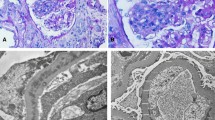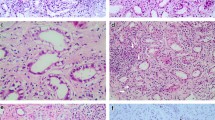Abstract
A 62-year-old female patient with essential thrombocythemia experienced rapid renal dysfunction and was subsequently referred to our hospital. Further investigations did not reveal any significant abnormalities except for a slight increase in urinary β2-microglobulin levels. A renal biopsy was performed to investigate the cause of her renal dysfunction, revealing acute tubular necrosis, interstitial edema, and arteriosclerosis. No significant glomerular lesions were observed. Immunofluorescence staining and electron microscopy showed no abnormalities. She had been using anagrelide for 4 years, and her dosage was increased from 2.0 to 3.0 mg/day 10 months before her initial admission. Her renal function began to deteriorate 2 months after the anagrelide dosage increase. Although 0.625 mg of bisoprolol was initiated for tachycardia 3 months after the anagrelide dosage adjustment, we suspected that the acute tubular necrosis was associated with anagrelide administration. After transitioning from anagrelide to hydroxyurea and discontinuing bisoprolol, her renal function improved. This case suggests the importance of considering anagrelide as a potential cause of renal dysfunction in patients using this medication. Therefore, renal biopsy, combined with a comprehensive medical history, is crucial for evaluating the etiology of renal injury in such cases.




Similar content being viewed by others
References
Wagstaff AJ, Keating GM. Anagrelide: a review of its use in the management of essential thrombocythaemia. Drugs. 2006;66:111–31.
Kwiatkowski J, Kuliszkiewicz-Janus M, Rymer W, Jaźwiec B, Małecki R. Treatment of essential thrombocythemia with anagrelide is associated with an increased risk of worsened kidney function. Pharmacology. 2021;106:316–22.
Said SM, Leung N, Sethi S, Cornell LD, Fidler ME, Grande JP, Herrmann S, Tefferi A, D’Agati VD, Nasr SH. Myeloproliferative neoplasms cause glomerulopathy. Kidney Int. 2011;80:753–9.
Krečak I, Holik H, Martina MP, Zekanović I, Coha B, Gverić-Krečak V. Chronic kidney disease could be a risk factor for thrombosis in essential thrombocythemia and polycythemia vera. Int J Hematol. 2020;112:377–84.
Rodwell GEJ, Troxell ML, Lafayette RA. Renal tubular injury associated with anagrelide use. Nephrol Dial Transplant. 2005;20:988–90.
Birgegård G, Björkholm M, Kutti J, Lärfars G, Löfvenberg E, Markevärn B, Merup M, Palmblad J, Mauritzson N, Westin J, Samuelsson J. Adverse effects and benefits of two years of anagrelide treatment for thrombocythemia in chronic myeloproliferative disorders. Haematologica. 2004;89:520–7.
Moreno JCA, Bahmad HF, Febres-Aldana CA, Pirela A, Azuero A, Salami A, Poppiti R. Post-mortem assessment of vimentin expression as a biomarker for renal tubular regeneration following acute kidney injury. J Pathol Transl Med. 2021;55:369–79.
Au WY, Chan KW, Lui SL, Lam CCK, Kwong YL. Focal segmental glomerulosclerosis and mesangial sclerosis associated with myeloproliferative disorders. Am J Kidney Dis. 1999;34:889–93.
Tamura K, Haruhara K, Azushima K, Iwamoto T, Wakui H. Possible interesting link between Janus kinase 2 mutation and renovascular hypertension. J Clin Hypertens. 2018;20:805–6.
Rastaldi MP, Ferrario F, Giardino L, Dell’antonio G, Grillo C, Grillo P, Strutz F, Müller GA, Colasanti G, D’Amico G. Epithelial-mesenchymal transition of tubular epithelial cells in human renal biopsies. Kidney Int. 2002;62:137–46.
Kellum JA, Romagnani P, Ashuntantang G, Ronco C, Zarbock A, Anders HJ. Acute kidney injury. Nat Rev Dis Prim. 2021;7:52.
Palmblad J, Björkholm M, Kutti J, Lärfars G, Löfvenberg E, Markevärn B, Merup M, Mauritzson N, Westin J, Samuelsson J, Birgegård G. TPO, but not soluble-IL-6 receptor, levels increase after anagrelide treatment of thrombocythemia in chronic myeloproliferative disorders. Int J Med Sci. 2008;5:87–91.
Lahiri P, Chaudhuri U, Chattopadhyay A, Dasgupta AK. Platelet aggregation profile as a marker of hydroxyurea bioavailability through nitric oxide generation in chronic myelogenous leukemia. Leuk Lymphoma. 2006;47:741–6.
Author information
Authors and Affiliations
Corresponding author
Ethics declarations
Conflict of interest
The authors have declared that no conflict of interest exists.
Ethical approval
This article does not contain any studies with human participants or animals performed by any of the authors.
Informed consent
Written informed consent was obtained from the patient for the publication of information and images.
Additional information
Publisher's Note
Springer Nature remains neutral with regard to jurisdictional claims in published maps and institutional affiliations.
About this article
Cite this article
Sawase, A., Kitamura, M., Morimoto, M. et al. Renal tubular necrosis associated with anagrelide administration: a case report. CEN Case Rep (2024). https://doi.org/10.1007/s13730-024-00881-3
Received:
Accepted:
Published:
DOI: https://doi.org/10.1007/s13730-024-00881-3




